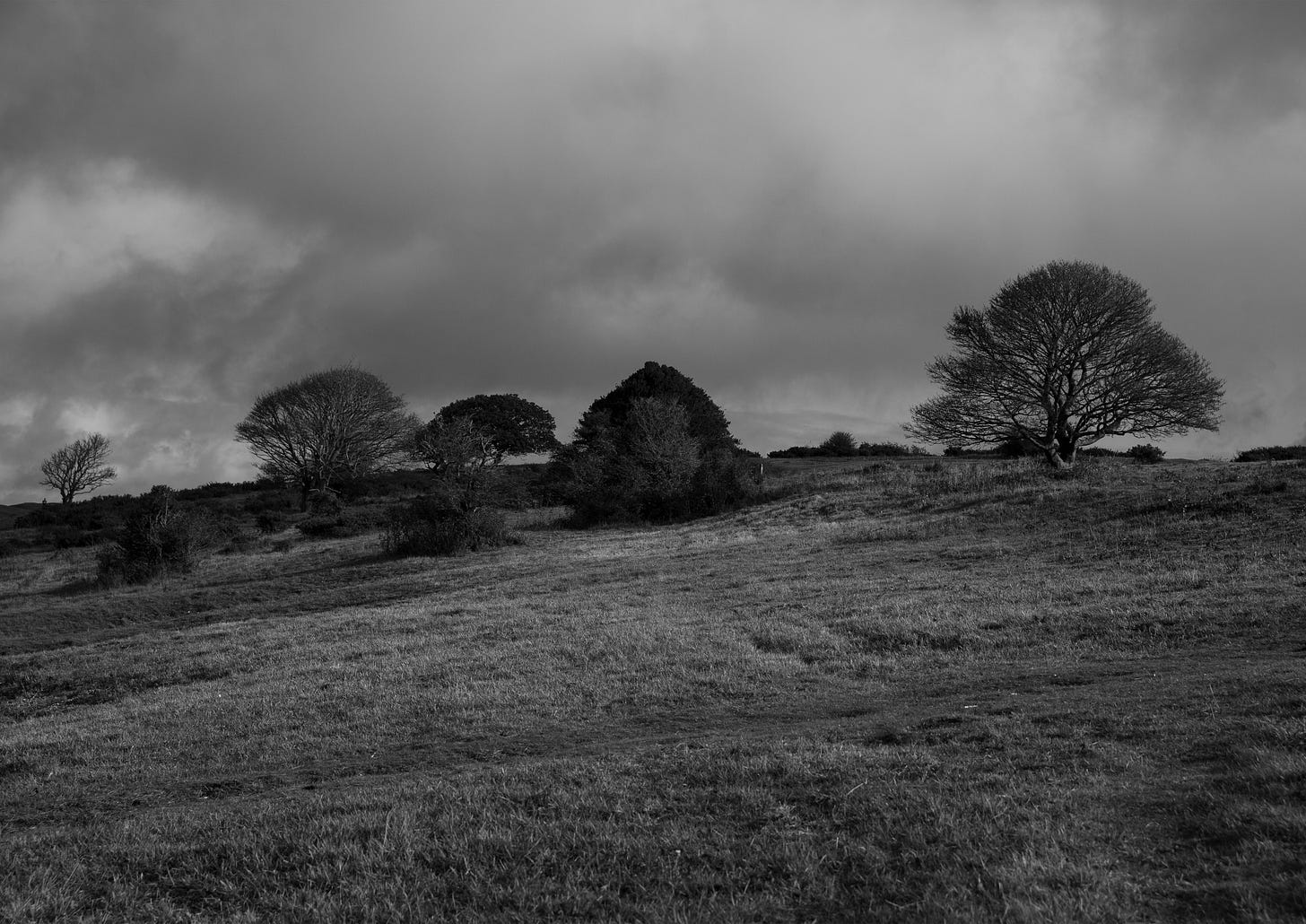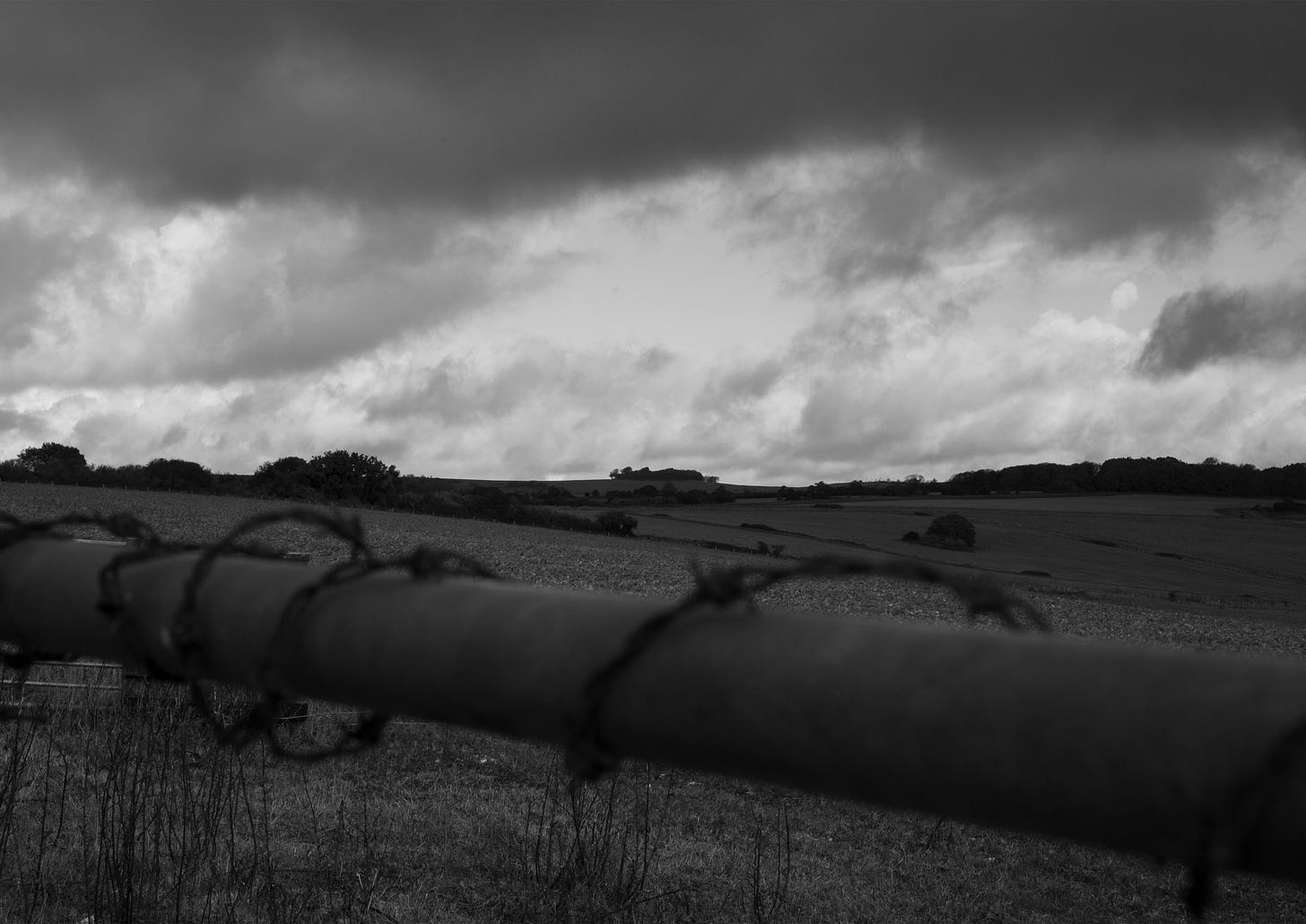Welcome to my second substack newsletter, thank you for reading along. Here, I am sharing some thoughts and images from Unseen, a photographic project documenting a series of intuitive walks in sites of historical, archaeological and spiritual interest around my home county of Sussex. Unseen is a search for the sublime and spirit of place, in both the land and self. This edition of my newsletter charts a walk up on Cissbury Ring, a prehistoric earthwork just north of Worthing. Folklore has it that faeries dance here on Midsummer’s eve. As I wander, I wonder if they dance on the eve of Samhain too.
Samhain
Samhain, or Samhuinn, is a Celtic pagan festival celebrating the beginning of Winter and the darker half of the year. One of the seasonal festivals of the Druid eightfold year, Samhain falls on the first of November, it marks the end of the harvest season and lies halfway between the autumnal equinox and winter solstice. As the trees shake off their leaves, it is a time for us to reflect and shake off the unwanted aspects of the past year.
For the ancient transhumant herders, this was an important time of year, livestock were moved back to their winter grazing ground from their highland summer pastures and either slaughtered or blessed. The Gods were called upon to protect the cattle, and the harvest stores, which would sustain the community through the harsh winter months.
On Samhain eve, from sunrise to sunset, fires were lit to cleanse and protect. Mimicking the strength of the sun and its powers for growth, it was believed the fire also protected people and property against the spirits. At this time of year ancient burial mounds were open to provide the living with a portal to the otherworld. Like Beltane on the first of May, this is a time when the veil that separates the worlds is at its thinnest and pathways between the dead, the living and the spirits can be crossed. The Celtic aos sí, or faeries, would cross over from the spirit world and visit the land of the living. These nature spirits, remnants of the pagan gods, were said to exist everywhere, but especially around the borderlands, the shores between land and water, the burial mounds and the edges of the woods. People would leave offerings to the aos sí in the hope they wouldn’t make mischief for them and that they would protect them through the winter months.
Samhain is also a time for honouring the dead, as the souls of the deceased revisit the land of the living. Traditionally, tables were laid with an extra place and an additional seat placed by the fire to provide hospitality and welcome back the family members who have passed. It is a time of ghosts and witches as Queen Cailleach, the goddess of winter, rules the night. Samhain is the witches’ sabbath and a time for gathering together, spell casting and prophesising.
They say the faeries and the ghosts of our forebears wander with us at Samhain and so I mark this liminal time of year with a walk up at one of Sussex’s historic landmarks - Cissbury Ring. The largest hillfort in Sussex, it succeeded Chanctonbury Ring as a place of significance for our prehistoric ancestors. The striking landscape still bears the marks of what was once one of of the country’s first Neolithic flint mines. Beneath my feet lies a vast, unseen warren of subterranean shafts and tunnels. Above ground, the undulating hollows and mounds show where the land has sunken into the mineshafts and where excavated chalk was deposited. The area was mined for flint over five thousand years ago and operated for about five hundred years. Then, during the Bronze Age, Cissbury was used as a ritual burial ground with round barrows constructed for the remains of the dead and ancestor worship. It wasn’t until around 400BC it became a defensive Iron Age hilltop enclosure. Later, the Romans came and raised the ramparts at Cissbury; and it’s possible the Saxons minted coins here during the eleventh century. Medieval farmers used the land for grazing and people have visited and wandered here for centuries since. Cissbury Ring has a long and rich history - to wander here is to step into deep time.
Cissbury is a beautiful but strange place, to me, there is a sadness to it. As I walk around the chalk path encircling the summit I take in the surroundings. Look north and there are views of farmland and in the distance, not too far, I can make out the familiar beech trees of Chanctonbury Ring. To the south, between the hillfort and the ocean, is the sprawling seaside town of Worthing. When I look west from the top of the ramparts, I see the creeping housing estate curving round the bottom of the hill. It’s a weird juxtaposition, this ancient site standing alongside a bunch of uniform modern bungalows below. Within the enclosure, beneath the leafless oaks, the wild ponies graze; and by the edge of the bramble and gorse, shaggy parasol mushrooms glow creamy white in the damp shadows. Perhaps these are a sign of the dancing Faeries that Cissbury mythology speaks of?
Today, the intermittent Samhain sun has me sweating beneath my heavy woollens, I feel uncomfortable. I have walked up at Cissbury several times and each time have felt an uncanny sense of unease. I wander aimlessly, scurrying down into the pits and scrambling up over the mounds. A few of the hollows have been cleared of shrub and bramble, at the bottom of one there’s a vintage Schweppes lemonade can from the days when you pulled the whole ring pull off. I quite like finding things like this, discarded in the 1980s and unearthed decades later, a bit of twentieth century archaeology. I feel a pang of nostalgia for the days of fully detachable ring pulls. As I traipse through the damp grass my leg gets caught on a low lying bramble, thorny and sharp it acts like a tripwire and cuts into my skin. I have a strong sense that I just want to go home. I hurry back to the car and look longingly at Chanctonbury Ring, a much preferred haunt with its invigorating and intoxicating atmosphere; here all I feel is sadness. I peel off the layers, shake off the melancholy and head home where tea and comfort awaits.









